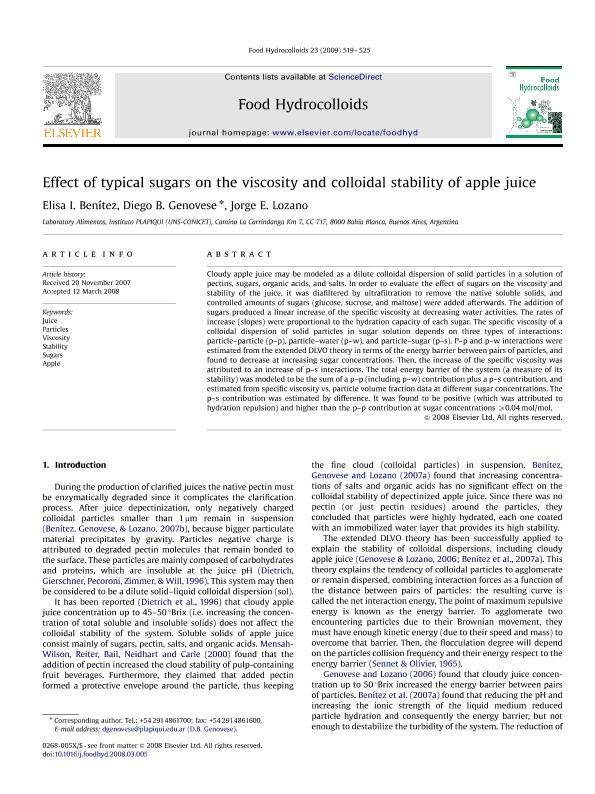Mostrar el registro sencillo del ítem
dc.contributor.author
Benitez, Elisa Ines

dc.contributor.author
Genovese, Diego Bautista

dc.contributor.author
Lozano, Jorge Enrique

dc.date.available
2018-09-07T15:50:42Z
dc.date.issued
2009-03
dc.identifier.citation
Benitez, Elisa Ines; Genovese, Diego Bautista; Lozano, Jorge Enrique; Effect of typical sugars on the viscosity and colloidal stability of apple juice; Elsevier; Food Hydrocolloids; 23; 2; 3-2009; 519-525
dc.identifier.issn
0268-005X
dc.identifier.uri
http://hdl.handle.net/11336/58695
dc.description.abstract
Cloudy apple juice may be modeled as a dilute colloidal dispersion of solid particles in a solution of pectins, sugars, organic acids, and salts. In order to evaluate the effect of sugars on the viscosity and stability of the juice, it was diafiltered by ultrafiltration to remove the native soluble solids, and controlled amounts of sugars (glucose, sucrose, and maltose) were added afterwards. The addition of sugars produced a linear increase of the specific viscosity at decreasing water activities. The rates of increase (slopes) were proportional to the hydration capacity of each sugar. The specific viscosity of a colloidal dispersion of solid particles in sugar solution depends on three types of interactions: particle–particle (p–p), particle–water (p–w), and particle–sugar (p–s). P–p and p–w interactions were estimated from the extended DLVO theory in terms of the energy barrier between pairs of particles, and found to decrease at increasing sugar concentrations. Then, the increase of the specific viscosity was attributed to an increase of p–s interactions. The total energy barrier of the system (a measure of its stability) was modeled to be the sum of a p–p (including p–w) contribution plus a p–s contribution, and estimated from specific viscosity vs. particle volume fraction data at different sugar concentrations. The p–s contribution was estimated by difference. It was found to be positive (which was attributed to hydration repulsion) and higher than the p–p contribution at sugar concentrations ⩾0.04 mol/mol.
dc.format
application/pdf
dc.language.iso
eng
dc.publisher
Elsevier

dc.rights
info:eu-repo/semantics/openAccess
dc.rights.uri
https://creativecommons.org/licenses/by-nc-nd/2.5/ar/
dc.subject
Apple
dc.subject
Juice
dc.subject
Particles
dc.subject
Stability
dc.subject
Sugars
dc.subject
Viscosity
dc.subject.classification
Otras Ingeniería Química

dc.subject.classification
Ingeniería Química

dc.subject.classification
INGENIERÍAS Y TECNOLOGÍAS

dc.title
Effect of typical sugars on the viscosity and colloidal stability of apple juice
dc.type
info:eu-repo/semantics/article
dc.type
info:ar-repo/semantics/artículo
dc.type
info:eu-repo/semantics/publishedVersion
dc.date.updated
2018-08-30T14:38:55Z
dc.journal.volume
23
dc.journal.number
2
dc.journal.pagination
519-525
dc.journal.pais
Países Bajos

dc.journal.ciudad
Amsterdam
dc.description.fil
Fil: Benitez, Elisa Ines. Consejo Nacional de Investigaciones Científicas y Técnicas. Centro Científico Tecnológico Conicet - Bahía Blanca. Planta Piloto de Ingeniería Química. Universidad Nacional del Sur. Planta Piloto de Ingeniería Química; Argentina
dc.description.fil
Fil: Genovese, Diego Bautista. Consejo Nacional de Investigaciones Científicas y Técnicas. Centro Científico Tecnológico Conicet - Bahía Blanca. Planta Piloto de Ingeniería Química. Universidad Nacional del Sur. Planta Piloto de Ingeniería Química; Argentina
dc.description.fil
Fil: Lozano, Jorge Enrique. Consejo Nacional de Investigaciones Científicas y Técnicas. Centro Científico Tecnológico Conicet - Bahía Blanca. Planta Piloto de Ingeniería Química. Universidad Nacional del Sur. Planta Piloto de Ingeniería Química; Argentina
dc.journal.title
Food Hydrocolloids

dc.relation.alternativeid
info:eu-repo/semantics/altIdentifier/url/https://www.sciencedirect.com/science/article/pii/S0268005X0800057X
dc.relation.alternativeid
info:eu-repo/semantics/altIdentifier/doi/http://dx.doi.org/10.1016/j.foodhyd.2008.03.005
Archivos asociados
